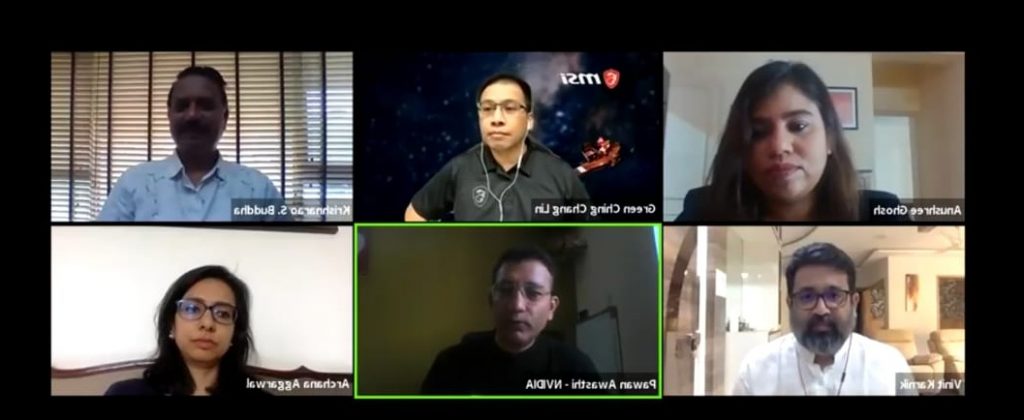Although the second session of GEMS 2020 was titled ‘Getting into the mainstream’, it saw a growing consensus on the fact that the last few months have already seen esports and gaming make inroads into the mainstream.
Taking a cue from the earlier session as to the popularity of live streaming, panelists acknowledged the huge potential of the gaming industry which has grown manifold over the last two years courtesy of the 4G boom.
Moderated by GroupM ESP business head Vinit Karnik, the panelists included ITC FOODS Business division head of digital strategy and media Anushree Ghosh, Parle Products Sr.category head – marketing Krishnarao S.Buddha, Airtel Media VP Archana Aggarwal, MSI regional marketing manager Green Chang-Ching Lin, NVIDIA South Asia head consumer marketing Pawan Awasthi.
Families are steadily realising that being a gamer and an esports player can be viable career options. Brands, media platforms, press are beginning to understand the potential, as well as the importance of reaching out to gamers and the audience who are following them. Basically, perceptions towards gaming and esports are on the cusp of a big change in India. The session saw interesting gateways of insights opening from every step of the value chain.
While Aggarwal agreed that esports space is booming with the influx of players investing in it, she also revealed that they are the title sponsors for NODWIN Gaming and sees a bright future for esports going forward.
Awasthi opened with the facts and figures substantiating the growth of gaming. He shared, “Globally there are close to a billion gamers. When we talk to gamers, 60 per cent of them game on the PC as a platform, not mobile. Worldwide, the average age is 30 plus. India is a mobile-first country. In India, it is less than 20 years of age, so we have a lot more younger audience and it is possible because of the hardware and the platform which mobile provides. It is the freemium model which is leading to the growth in India. Dynamo and Scout who game on mobile are creators who have around nine million subscribers so we also have creators too. And there are many of them. This is fuelling this particular growth.”
Chang-Chin Lin also discussed how they’re seeing India as one of the growing markets and they are planning to leverage it more in the coming years. He shared, “I am in charge of laptop marketing. We’ve been working on gaming laptops and talking to the community. India is one of the world’s fastest-growing markets. So especially for a mobile gamer, there’s a huge growth and so they’re also looking for a better device to enjoy their gameplay.”
On the marketeers side, Buddha and Ghosh noted that although they see a huge scope in gaming and esports, they still need more awareness, proof-points, case studies and means to understand how it can be a profitable investment.
Speaking of the growing interest in the gaming space, Ghosh shared, “Being the household brand with a whole lot of large CPG brand, we kind of traverse in terms of the target audience that one wants to reach out to. There is a large percentage of female population that is into casual gaming.”
Enumerating the challenges they face as marketeers, Ghosh explained, “To begin with, to advertise on gaming (and we do advertise on gaming) there are brands that talk to that 15-30 age group whether it is a snack brand or a confectionary brand, and we are consistently reaching out to these audiences. Our question is whether interruption-based communication becomes annoying especially when audiences are engaged and suddenly there is an advertisement.”
While brands are tinkering with the gaming space, there is a growing sense of reservation as to whether the gaming audience will take kindly to interruptions, given the engaged nature of the platform.
Ghosh added, “We also have questions around the efficacy of media advertising or if the mind measures really move if we have co-created a game on a particular platform. Does that drive effectiveness and efficiency? Because these are extremely engaged platforms again and the consumer is actually paying to get rid of advertising. Given the nature of the platform, the effectiveness of the platform needs to really be established.”
Panelists thanked AnimationXpress for taking the step in the right direction and filling the lacuna with regards to educating the ecosystem about the growing yet untapped gaming market.
We hope to activate more conversations between various players of the value chain to enable healthier, meaningful and informed partnerships between brands and gaming platforms. While currently the waters remain largely untested, the pace at which gaming sector seems to be growing, we’re sure brands would be lapping it up like bees to a honeypot in the not too distant future.


